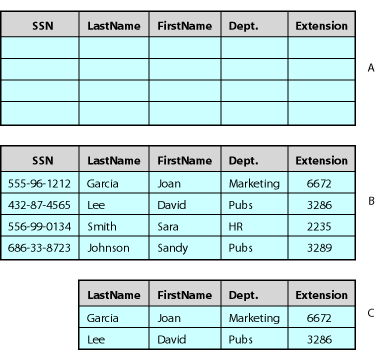 |
Databases
Databases organize information, such as names, addresses, and phone numbers, into records. A collection of records is called a table. Typically, rows in a database table are called records, and columns are called fields.
A relational database can contain tables that are related by a common field called a key field. The key field can be an ID number such as a social security number or serialized record number that is unique for each record.
You can extract a subset of data--a recordset or view or query--from a table. This subset is itself a table.

Databases used for content on a dynamic site need to be available to the site. GoLive uses databases or links to databases placed in the datasources folder of a site's config folder as sources for dynamic content
Database programs let you control access to a table by means of permissions. You can set permissions for a table so that a user can read, but not make changes to the table. When a database is accessed from a Web page, there are two identities involved. One is the identity under which the Web server is running. This Web server identity is often an anonymous Internet user identity that is defined on the server machine. For example, Microsoft's IIS Web server is configured by default to run with the identity IUSR_machine where machinename is the network name of the machine. The second identity is the database user identity. Most database systems have their own concept of user identities that is separate from that of the underlying operating system. When a database connection is made, a database username and password can be supplied. This is used as the database identity and it is this identity that determines the access privileges of the Web page. (See Understanding data sources for information on how to set the database identity of the database connection.)